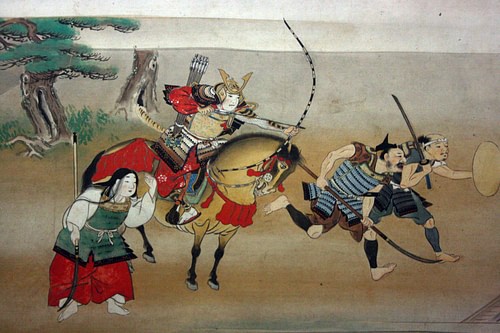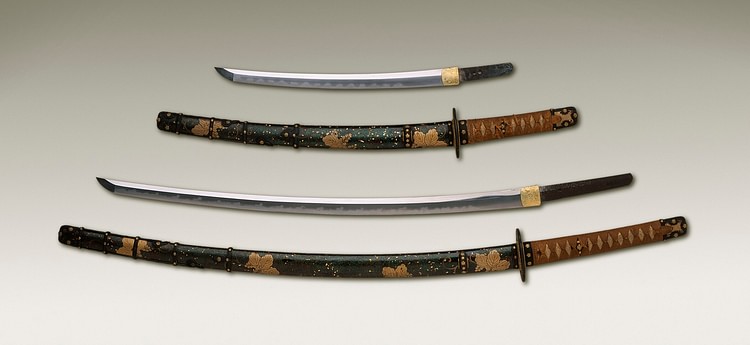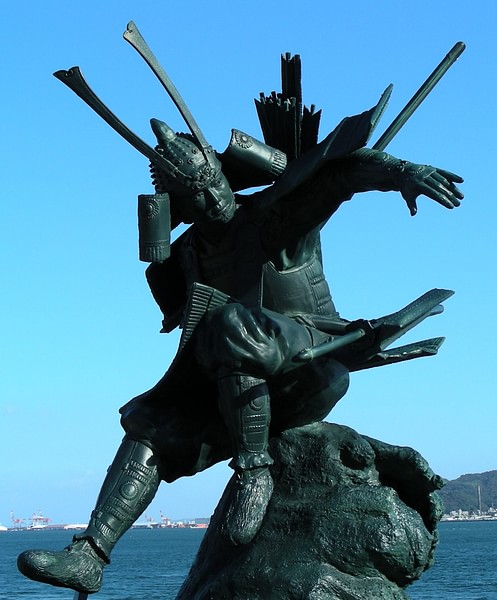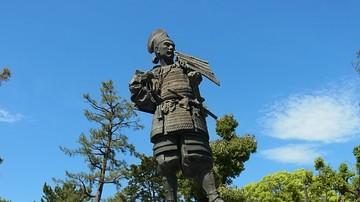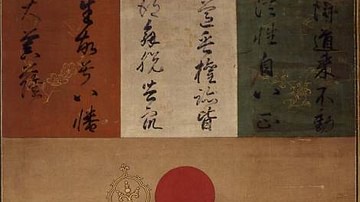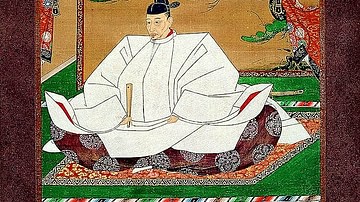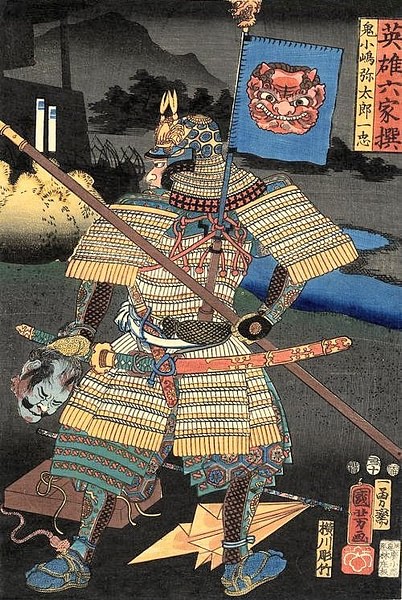
The samurai (also bushi) were a class of warriors that arose in the 10th century in Japan and which performed military service until the 19th century. Elite and highly-trained soldiers adept at using both the bow and sword, the samurai were an essential component of Japanese armies in the medieval period.
Samurai and samurai culture may have been excessively romanticised since the 18th century as the epitome of chivalry and honour but there are many examples of them displaying great courage and loyalty to their masters, in particular, even committing ritual suicide in the event of the defeat or death of their lord. Warfare in medieval Japan was, though, as bloody and as uncompromising as it was in any other region and money was often the prime motive for many samurai to participate in battle. From the 17th century, and no longer needed in a military capacity, samurai often became important moral teachers and advisors within the community.
Development & Status
The government system of conscription in Japan was ended in 792, and so in the following Heian Period (794-1185), private armies were formed in order to protect the landed interests (shoen) of nobles who spent most of their time away at the imperial court. This was the beginning of the samurai, a name meaning 'attendant' while the verb samurau means to serve and so the term was originally one of class rather than the military profession it later came to signify. There were other classes of warriors, too, but the samurai class was the only one with a connotation of serving the imperial court.
Samurai were employed by feudal lords (daimyo) for their martial skills in order to defend the lord's territories against rivals, to fight enemies identified by the government, and battle with hostile tribes and bandits. For this reason, samurai could live in barracks, in a castle or in their own private homes. As samurai eventually organised into groups led by warlords with political power they were able to take over from a weak imperial court in the 12th century under the rule of such warlords as Minamoto no Yoritomo. Thus, from the Kamakura period (1185-1333) a new military government system was founded which was dominated by warriors and led by a shogun (military dictator). and so it would remain right up until the 19th century.
Many samurai came from the Kanto plain and had gained valuable experience in the campaigns against the Emishi (Ainu) tribes in the north. In these battles, warriors began to develop a code of conduct which gave them the possibility to earn a reputation and increase their status amongst their peers and masters. Naturally, bravery on the battlefield was paramount, and a tradition developed of samurai riding into battle shouting out their lineage and past deeds and challenging any of the enemy to single combat. These vocal pronouncements would later be replaced by the use of banners in samurai culture.
It was not until the Edo period (1603-1868) that a fully standardised system of status and rankings developed for samurai. There were three principal ranks:
- gokenin (housemen), the lowest and vassals of a feudal lord.
- goshi (rustic warrior), they could farm their land but could not have the two swords of the full samurai rank.
- hatamoto (bannermen), the highest rank. Only these warriors were expected to die to protect their lord's interests.
All samurai were supervised by their lords, but from 1180, the national Samurai-dokor (Board of Retainers) was formed to particularly monitor gokenin and dish out disciplinary measures for any misdemeanours if and when required. From 1591, samurai were no longer permitted to be both farmers and warriors and had to choose one living or the other, the idea being this would make them more dependent and so more loyal to their masters.
Many samurai had their own dedicated assistants or baishin who also worked any land their master owned. Samurai made up just 5-6% of the total population (18 million in 1600), and none of these were women (although there was a separate and very small warrior class of women known as onna bugeisha or 'martially skilled women').
Samurai Weapons
Trained from aged 10 or even earlier in martial skills, samurai rode and fought on horseback in the early medieval period, primarily using a bow but also a curved long sword when necessary. They had a second, shorter sword, and a decree by the ruler Hideyoshi in 1588 stated that only full samurai could wear two swords, and this became an important status symbol. Samurai also learnt martial arts, of which there were 18 in the Edo period, but the most prized samurai skills were always horsemanship, archery and, then swordsmanship. From the 17th century, the sword took over from the bow as the quintessential samurai weapon - largely thanks to the bow being much cheaper and accessible to ordinary foot soldiers - and so the more exclusive sword became known as the 'soul of the samurai.' Both weapons suited the samurai ideal that battle should involve personal duels.
Bows were typically made using laminated bamboo strips around a wooden core. Cane might also be added for extra strength and the whole lacquered for protection against rain. Arrows varied in length depending on the skill of the archer, but a typical length in medieval times was 86-96 cm (34-38 inches). Shafts were made from young bamboo, heads were of iron or steel, and bird feathers were used to make three or four fletchings to give the arrow stability in flight. Fired from horseback, the rider's heavy wooden saddle with leather stirrups was designed to provide a stable platform and permit the rider to stand while firing.
Samurai swords were curved and made using steel - a design combination which dated back to the 8th century in Japan. The steel was worked by master craftsmen who carefully controlled the carbon content in various parts of the blade for maximum strength and flexibility. For this reason, it is fair to say that Japanese swords were amongst the finest and sharpest ever produced in the medieval world. Blades varied in length, but it became common for elite samurai to carry two swords - a long and a short one. The longer sword (katana) had a blade of around 60 cm (2 ft) and the shorter sword (wakizashi) had a blade of 30 cm. Both swords were worn with the cutting edge uppermost. The tachi, an earlier and even longer sword than the katana (with a blade of up to 90 cm / 3 ft), was worn with the cutting edge facing down, hung suspended from the belt while the other types were thrust through the belt. Sword handles were made of wood and covered in the tough skin of the giant ray (same) and then tightly bound in silk braid. The blade was separated from the handle by a small circular hand guard. A samurai might also carry a short dagger (tanto) as a weapon of last resort. The swords and daggers were kept in lacquered scabbards which could be highly decorative.
Early samurai also used weapons that later became more associated with ordinary infantry. These were the spear (yari) and polearm (naginata). The length of yari varied, but blades were double-edged and measured anywhere from 30 to 74 cm (12-29 inches) in length. Some blades were L-shaped and used to hook enemy riders from their horses. Spears were not usually thrown in Japanese warfare but used to jab at the enemy. The naginata was a long pole with a long curved single-edged blade attached to it. The pole part measured from 120 to 150 cm (4-5 ft) and the steel blade could measure up to 60 cm (2 ft). The weapon was used to sweep, cut, and thrust at an enemy, and using it became one of the martial arts, one particularly learnt by the daughters of samurai.
Gunpowder weapons were familiar to the Japanese through their contact with China, but it was the arrival of the first Europeans in the mid-16th century that eventually brought firearms into Japanese warfare. By the end of that century, perhaps one-third of field armies were equipped with guns - the matchlock arquebus - and some later samurai carried pistols.
Samurai Armour
Cuirasses made of metal plates stitched together and protected by lacquer date back to the Kofun period (c. 250-538). A more flexible armour was then made using narrow strips of bronze or iron which were held together with cord or leather ties. Leather plating was another common material for armour throughout the medieval period as it was both light and flexible. From the Heian period (794-1185) samurai often wore a silk cloak (horo) over their armour which was fastened at the neck and waist while riding. It was designed to inflate with passing air and either deflect arrows or act as an identifier of the wearer.
There were suits of armour such as the box-like oyoroi which hung from the shoulders. This type weighed around 30 kilos (62 lbs) The simpler and more flexible haramaki suit had a closer-fitting cuirass for the torso and a short skirt made up of eight sections. The thighs might be protected by guards (haidate), the lower legs were protected by greaves or suneate, and the hands and forearms by half-armour sleeves or kote. Once firearms appeared on the battlefield, a solid plate of armour for the chest became popular and these were often imported or copied from Europe. Curiously, despite all this body protection and perhaps not having yet heard of the Achilles story, samurai did not protect their feet and only wore socks and simple rope sandals.
A samurai's helmet (kabuto) was most frequently made from riveted iron or steel plates and took the form of a skullcap with projecting flaps at the sides and neck for extra protection. On occasion, a face-mask or menpo with fierce sculpted features and moustaches was worn. Some helmets had impressive crests in the form of crescents, horsehair plumes or animal horns and antlers (real or stylised) but these were more usually worn by daimyo. To increase comfort under a helmet, samurai often shaved the front portion of their hair which became a fashion by the 16th century. The rest of the hair was worn long and tied at the back of the head in either a bun (chasen-gami) or a three-times folded cylinder of hair (mitsu-ori). In battle, samurai let their hair down (in every sense).

Medieval armour and helmets typically indicated a samurai's rank, division, and home region via their coloured stitching, heraldic badges, and painted symbols, some of which were associated with their families or military house (buke). Dragonflies were a popular symbol on armour because that insect cannot fly backwards and so it represented the no-retreat mentality of the samurai. Banners were also used to identify who was who on the battlefield, although their size was controlled and linked to the samurai's particular status.
Bushido
The bushido or shido, meaning the 'way of the warrior,' is the famous warrior code of conduct the samurai followed, but it was only compiled in the late 17th century by the scholar Yamago Soko (1622-1685), by which time the samurai were no longer active militarily but functioned more as moral guides and advisors. It is, therefore, difficult to ascertain the level of chivalry samurai actually practised throughout their history. It would seem likely that, just as any warrior in any other culture, pragmatism would have ruled the day when fighting actually took place. There was, undoubtedly, much courage and martial expertise displayed by samurai, but promises and truces were frequently violated, villages were burned, and the defeated slaughtered, as honour came from victory and nowhere else. Samurai were, above all, motivated by financial gain and advancing their social position, hence the unsavoury obsession with collecting the severed heads of their victims. It is also true that despite the chivalrous reputation of warriors superimposed in later times on Japanese medieval history, especially in terms of austerity, loyalty and self-discipline, it was not at all uncommon for mass defections to occur during battles, including generals. At the Battle of Sekigahara in 1600, for example, no fewer than five generals and their armies switched sides mid-battle.
Samurai were not always very noble when it came to the peasantry either. The warriors became infamous amongst later European visitors for beheading total strangers on the roadside just to test their swords were still sharp, a nasty habit known a tsujigiri or 'cutting down at the crossroads.' Still, the samurai did have the law on their side as they had been specifically granted the right by the Tokugawa Shogunate (1603-1868) to kill anyone of lower rank than themselves if they considered that person to be acting rudely - loosely defined as 'acting in an unexpected manner.'
Seppuku
Those in the top echelons of the samurai were expected to fight to the death, even if this meant killing oneself to avoid capture. The honourable method was seppuku (aka hara-kiri) or self-disembowelment as the stomach was considered to contain the spirit, not the heart. The warrior first donned a white robe, symbol of purity, and then cut his abdomen with a knife stroke from left to right. Not being a particularly fast or efficient method of suicide, an assistant was usually on hand with a special sword, known as a kaishakunin, to decapitate the samurai. Just as a samurai often committed suicide when his lord had done so, the followers and retainers of a samurai were similarly expected to kill themselves on the loss of their master in a code known as junshi or 'death by following.'
Samurai as Heroes: Yoshitsune
Many heroes in Japanese mythology are samurai warriors and none is more famous than the legendary Yoshitsune (1159-1189). Minamoto-no-Yoshitsune, born Ushiwakamaru, was the younger brother of the shogun and a successful general in the Gempei War (1180-1185). His legendary status springs from his standing as the epitome of the loyal, honourable, and unflappable warrior. He was taught fencing as a youth, rid the countryside of several robbers, and compelled the warrior-monk Benkei to become his faithful servant. Winning many battles, notably leading a cavalry charge at Ichinotani and leaping a boat bridge at Danno-Ura, he eventually aroused his brother's jealousy. Yoshitsune, consequently, fled to northern Japan, only passing the border controls when Benkei beat him in pretence that Yoshitsune was a hapless servant. There was to be no happy end for the hero, though, for the shogun eventually found and blockaded Yoshitsune in a castle which was then burnt to the ground. In some versions of the myth, Yoshitsune escaped to become the Mongol prince Temujin, later to be known as Genghis Khan. The story of Yoshitsune became a staple theme of Kabuki and Noh theatre.
The 47 Ronin
Perhaps the most famous real-life samurai, episode of mass-seppuku, and example par excellence of maintaining honour through death is the story of the 47 Ronin (Shijushichishi) which occurred in January 1703 (although commemorated today every December 14). The lord of Ako, Asano Naganori (1665-1701) was at the castle of the shogun in Edo one day when he was insulted by the shogun's (not so diplomatic) chief of protocol, Kira Yoshinaka (1641-1701). Naganori foolishly drew his sword, an act which carried a capital offence within the walls of the castle, and so he was compelled by the shogun to commit seppuku. However, his 47 samurai followers, known now as ronin ('wanderers' or 'masterless samurai') swore revenge on Yoshinaka. Biding their time for two years, they finally got their man and put his decapitated head on the grave of their fallen master. The ronin were punished for their crime after much public debate and given the option of execution or seppuku. 46 (the missing figure is unaccountable), aged between 15 and 77, decided to accept seppuku and so guarantee their legendary status as the greatest followers to the letter of the samurai code. The ronin were buried beside their master at the Sengakuji Temple.
Decline & Subsequent Mythologising
The importance of samurai and local armies was greatly reduced following the stabilising policies of the Tokugawa Shogunate which brought relative peace across Japan. This continued the process begun half a century earlier when the rural populace was disarmed. In addition, many samurai, faced with becoming either peaceful farmers or retainers to local lords when there was no warfare to speak of, consequently, became teachers, administrators (especially in finance), and moral guides. Samurai still enjoyed an elevated social status, being members of the shi rank, which placed them above merchants, artisans, and farmers within the shi-no-ko-sho ranking system. In 1872 conscription was reintroduced in the Japanese army, and in 1876 the samurai were formally disestablished, although descendants of former samurai continued to be distinguished with the title of shizoku up to the Second World War.
Samurai and their martial exploits were popular subjects in the gunkimono or warrior tales of the 14th and 15th century, which nostalgically looked back at earlier medieval times. The 18th century in Japan saw an even greater romanticisation of the samurai. For example, the famous opening line of the Hagakure by Yamamoto Tsunetomo, a collection of 1,300 anecdotes related to samurai compiled in 1716 during peacetime, boldly states that 'Bushido is a way of dying.' The reputation of samurai has continued to flourish today thanks to comic books, computer games, and other media, ensuring their status as one of the great warrior groups of world medieval history.
This content was made possible with generous support from the Great Britain Sasakawa Foundation.
